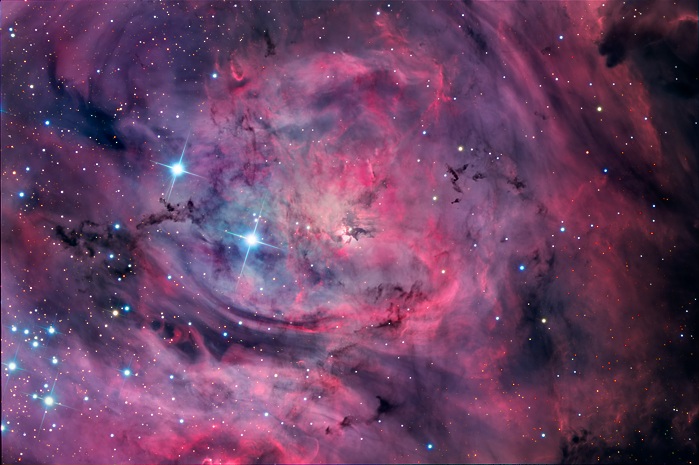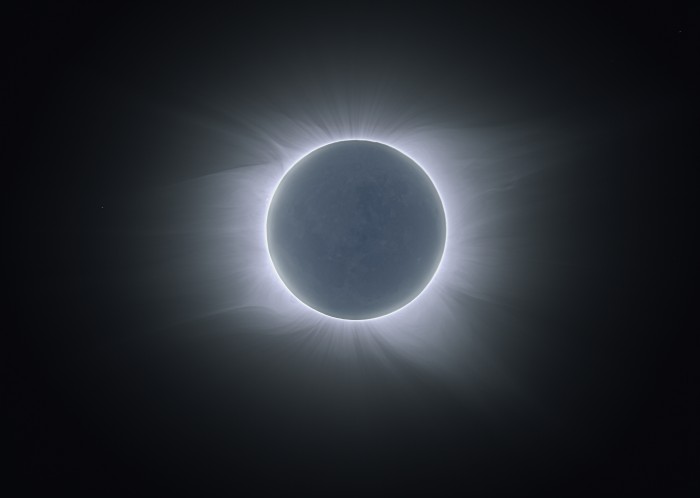Panorama of Our Solar System
This artistic montage of our solar system — 30,000 pixels wide, 18MB in size — might be the coolest thing I’ve seen in a long time:
It’s not scientifically correct, to be sure, but awe-inspiring nonetheless. To think this is but one solar system in a universe where there are more stars than grains of sand on all of the beaches on Earth!
M8: The Lagoon Nebula
From NASA APOD:
This beautiful cosmic cloud is a popular stop on telescopic tours of the constellation Sagittarius. Eighteenth century cosmic tourist Charles Messier cataloged the bright nebula as M8. Modern day astronomers recognize the Lagoon Nebula as an active stellar nursery about 5,000 light-years distant, in the direction of the center of our Milky Way Galaxy. Remarkable features can be traced through this sharp picture, showing off the Lagoon’s filaments of glowing gas and dark dust clouds. Twisting near the center of the Lagoon, the bright hourglass shape is the turbulent result of extreme stellar winds and intense starlight. The alluring view is a color composite of both broad and narrow band images captured while M8 was high in dark, Chilean skies. It records the Lagoon with a bluer hue than typically represented in images dominated by the red light of the region’s hydrogen emission. At the nebula’s estimated distance, the picture spans about 30 light-years.
Credit: Steve Mazlin, Jack Harvey, Rick Gilbert, and Daniel Verschatse (Star Shadows Remote Observatory, PROMPT, CTIO)
Lawrence Krauss on a Universe from Nothing
Here’s an awesome talk by Lawrence Krauss on the structure of the universe, the current state of Cosmology, and why what our remote descendants will eventually conclude about the universe, based on observation, will be completely wrong:
Lawrence Krauss gives a talk on our current picture of the universe, how it will end, and how it could have come from nothing. Krauss is the author of many bestselling books on Physics and Cosmology, including “The Physics of Star Trek.”
One of my favorite Lawrence Krauss quotes comes from this talk:
Every atom in your body came from a star that exploded. And, the atoms in your left hand probably came from a different star than your right hand. It really is the most poetic thing I know about physics: You are all stardust. You couldn’t be here if stars hadn’t exploded, because the elements - the carbon, nitrogen, oxygen, iron, all the things that matter for evolution and for life - weren’t created at the beginning of time. They were created in the nuclear furnaces of stars, and the only way for them to get into your body is if those stars were kind enough to explode. So, forget Jesus. The stars died so that you could be here today.
The Sun Compared to Other Stars
In this picture (click for full size), the Sun, which is 109 times larger than the Earth, represents only a single pixel. Think about that for a second. Now consider that the largest star shown, VY Canis Majoris, isn’t even the most massive we know of; that title belongs to R136a1, a star that shines 10 million times brighter than the Sun and has a surface temperature of roughly 40,000 degrees celsius. Incomprehensible.
I wonder what these celestial monstrosities would be to those of our ancestors who thought a god of our little pixel.
The Crown of the Sun
From NASA APOD:
During a total solar eclipse, the Sun’s extensive outer atmosphere, or corona, is an inspirational sight. Subtle shades and shimmering features that engage the eye span a brightness range of over 10,000 to 1, making them notoriously difficult to capture in a single photograph. But this composite of 7 consecutive digital images over a range of exposure times comes close to revealing the crown of the Sun in all its glory. The telescopic views were recorded from the Isla de Pascua (Easter Island) during July 11’s total solar eclipse and also show solar prominences extending just beyond the edge of the eclipsed sun. Remarkably, features on the dim, near side of the New Moon can also be made out, illuminated by sunlight reflected from a Full Earth.
Credit: Alain Maury and Jean-Luc Dauvergne


